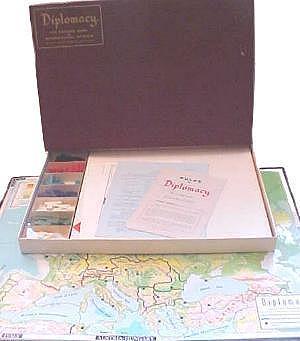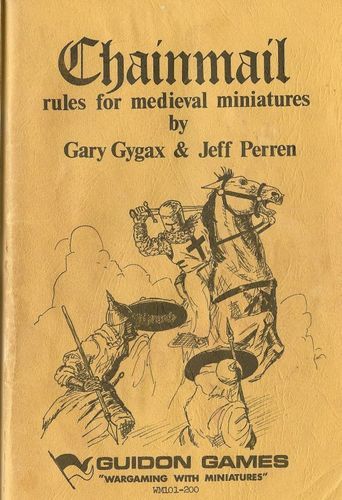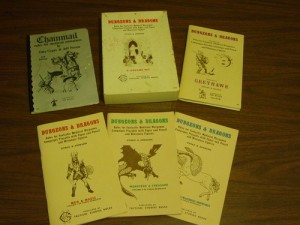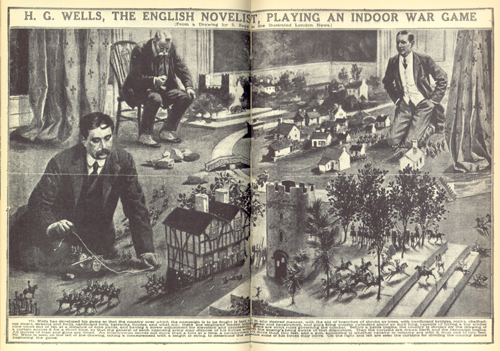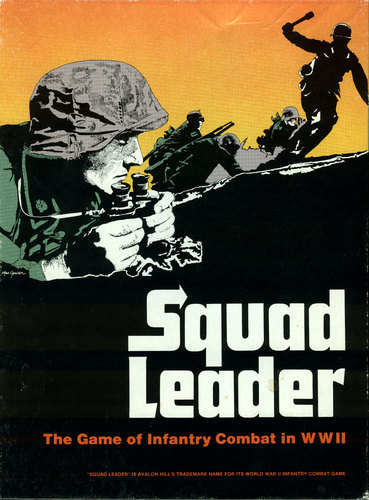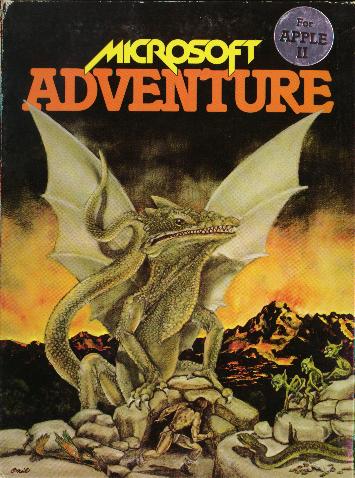Although wargames were sold commercially from 1954, and at least the big players like Avalon Hill made considerable profits from them, much innovation in the field was driven by a network of active, committed hobbyists who formed clubs and held meet-ups to swap stories, tweaks, miniatures, and even whole new games amongst themselves in ways not so different from early computer enthusiasts like the Homebrew Computer Club.
In 1959 a Harvard Law School dropout named Allan Calhamer self-published a game of his own design, Diplomacy, in a 500-copy run. Set in Europe on the eve of the First World War, this grand strategy game might at first seem a fairly typical entrant into the burgeoning wargame hobby that Avalon Hill had opened up just a few years before. Each player controlled one or more of seven possible countries, with the ultimate goal being the military conquest of Europe. A closer look, however, revealed a very unusual design indeed. In this game the management of armies and the mechanics of conquest were almost an afterthought. Instead the real meat of the game, as its name would imply, centered on social interactions and negotiations amongst the players. Every Diplomacy player is actively, explicitly asked to embody the leader of a European power in negotiations with his peers. Other wargames had and would continue to make superficially similar requests, implicitly and sometimes explicitly; the box copy of 1964’s Afrika Korps, for instance, states, “Now YOU command in this realistic desert campaign game by Avalon Hill.” However, playing Rommel in Afrika Korps ultimately still came down to just moving bits of cardboard around a game board; no one came to a session dressed in a German army uniform and proceeded to rant about the interference of Hitler and his cronies back in Berlin. Yet exactly this kind of theater was common among hardcore Diplomacy players. After being picked up by a real publisher a couple of years later, Diplomacy went on to become an enduring classic that is still sold and played today.
A major hotspot of early wargaming was the American Midwest, where organizations like the Midwest Military Simulation Association and the Lake Geneva Tactical Studies Association were springing up in numbers by the mid-1960s. A particularly active member of the former group was a university physics student and Minneapolis-area resident named Dave Wesely, who devoured not only the products of the wargame industry but also whatever literature he could find in the library pertaining to the still nascent field of game theory. In 1967 he combined ideas from a number of sources to create what was arguably the first true ludic narrative.
The game Braunstein started like a rather typical wargaming scenario, with Wesely preparing a detailed game board representing the area around the fictional Prussian town of Braunstein. At the heart of the game would be a hypothetical battle between the invading forces of Napoleon and a Prussian garrison defending the town. Its fictional rather than historical scenario was a bit unusual, but hardly unheard of in wargame circles. What marked the game as truly unique were the innovations Wesely deployed around the tried and true wargame framework, some of which he owed to Diplomacy.
In the fashion of that game, Wesely asked each of his players to embody the role of someone in his scenario. Two of these roles were obvious: the commanders of the two opposing armies, standing in for the leaders of nations of Diplomacy. Wesely, however, took the role-playing aspect much further this time, also creating roles for an advance scout for the French army; for the town’s mayor, concerned not so much with military glory as with minimizing the death and destruction the battle would visit on his town; for the local university chancellor; even for some university students of questionable loyalty and with radical agendas of their own (shades of the real-life political milieu of 1967). To facilitate all of these disparate personalities and agendas, Wesely acted as an impartial referee for the group as a whole. First he pulled each player aside before the game began and gave him a quick sketch of the personality and the goals of the character he would be play; later, during the game itself, he oversaw everything, informing the different players of what was going on from their perspective to maintain a “fog of war” and, of course, performing as judge and jury for everything that transpired. That was the plan, anyway; in the first actual play of Braunstein something close to complete chaos reigned. Sean Patrick Fannon described the scene in The Fantasy Roleplaying Gamer’s Bible:
Wesely had not counted on the imagination and enthusiasm of his players. They were almost immediately enchanted with the idea of assuming a single role with special and secret goals. Within minutes of the game’s start (in fact, even before it got officially underway, I am given to understand), players were off in various corners of the house conspiring and discussing with one another.
In a sense the negotiations and betrayals that transpired were not all that far removed from an enthusiastic session of Diplomacy. However, Braunstein was different in rooting its context in such a specific fictional scenario, and in offering the players such a smorgasboard of distinctly defined fictional personalities to play. And unlike Diplomacy, which was ultimately a zero-sum game with winning and losing sides, the goal of Braunstein was really just to play, to inhabit a character in this storyworld. More from Fannon:
When Wesely got wind of what was happening, he tried to reign it in. People would come and ask him things out of turn; when he asked how it was the University student was in communication with the advance French scout (since his miniature was still in the town), the player shrugged and said, “Let’s pretend that I swam the river and got out there, OK?” Wesely, trying to ensure everyone was having a good time, endeavored to acquiesce as much as possible.
Wesely actually left that first play session dejected, believing the structure of the game to have broken down so badly that the result couldn’t have been satisfying for anyone. In this he was mistaken; players were soon begging him to do it again. After running several more sessions, Wesely joined the Army and left Minneapolis. By the time he did, though, his new approach to gaming had infected his friends. Amongst the biggest fans of the new approach was a fellow named Dave Arneson, who took up the mantle of Braunstein and began running sessions of his own, first using Wesely’s original scenario and then others of his own devising.
Arneson was in some ways an ideal figure for the task. Unlike many wargamers, who could obsess for hours over the most minute of rules, Arneson was interested in game design only so much as it allowed him to open up storytelling vistas for the imagination; he was the prototypical context-focused gamer, in for the fictional experience being simulated rather than any fascination with the underlying game system. A similar impulse drew him to the writings of an author who was exploding in popularity during the late 1960s, J.R.R. Tolkien. His interests being what they were, Arneson gradually began to drift away from the military themes of traditional wargaming toward Tolkienesque fantasy. By 1970 he had created a fantasy realm of his own, which he called Blackmoor, to play host to a long-term campaign, in which his players could live out entire careers for their characters via a series of interconnected adventures. His players liked the idea, and loved the rich tapestry of politics and history and ecology Arneson wove into Blackmoor, but on a practical level play there was difficult and frustrating. Arneson’s strength was the soft art of world-building rather than the hard science of rules design. With no established rules to draw upon, as had been the case with his more wargame-like scenarios, he was largely reduced to making things up as he went along, a process that felt capricious and arbitrary to his players. So, Arneson and friends went looking for some rules they might adapt for Blackmoor. They found them in a little black and white booklet called Chainmail: Rules for Medieval Miniatures and in particular in its Fantasy Supplement, which featured rules for magic use and a roster of mythical creatures to battle.
Chainmail was itself a product of the Midwest wargaming scene, published by a tiny company called Guidon Games, based in Indiana. In fact, Arneson knew Chainmail‘s principal author very well, having already collaborated with him on a Napoleonic naval game called Don’t Give Up the Ship! His name was E. Gary Gygax.
Gygax was a twenty-year-old odd-jobber and sporadic university student in 1958, when he discovered one of Avalon Hill’s earliest games, Gettysburg, on a shop shelf in Chicago. A pedantic, somewhat fussy personality with little use or patience for conventional classroom education, Gygax had been throughout his life fascinated with the workings of complex systems. Had he been exposed to computers early in life, there’s a good chance he would have become a natural hacker. Since he was not, though, he did his hacking on games. Chess was his first love, but Gettysburg opened his eyes to a whole new world of ludic possibilities. Even as he married and settled down to father five children, Gygax devoted more and more energy to the hobby, not just playing regularly but tinkering with and occasionally publishing via the fan press rules, scenarios, and philosophy. In 1966 he co-founded the grandiosely named International Federation of Wargamers. In 1968 he organized the first edition of an annual wargaming convention, Gen Con, held in the erstwhile hometown to which he had recently returned, the Wisconsin resort town of Lake Geneva. By this time Gygax was one of the leading figures in hobbyist circles, especially around the Midwest.
It’s probably an oversimplification to say that Dungeons and Dragons was a combination of Arneson’s imagination and big-picture theorizing and Gygax’s attention to detail and rules lawyering, but certainly that seems to describe the general thrust of each man’s contributions. By 1972 Arneson had progressed beyond merely adapting Chainmail to his purposes to regularly meeting and corresponding with Gygax to develop a whole new system of rules. Together they abandoned the traditional wargame mechanics of Chainmail, in which every playing piece represented about 20 soldiers, to develop a game that took place largely in the imagination rather than on the tabletop, one in which every player assumed the role of a single individual in the storyworld, interacting with one another and the rest of the storyworld under the guidance of a referee. Arneson was not always patient with Gygax. (“He literally had a small book on different kinds of polearms, which I regard as the ultimate in silliness,” Arneson once said. “It’s a pointy thing on the end of a stick!”) Still, in this formative period D&D needed Gygax’s rigorousness as much as it needed Arneson’s world-building vision. In a decision he would later have great cause to regret, Arneson largely left it to Gygax to document their innovations, and to publish them under his own tiny Tactical Studies Rules (TSR) imprint in January of 1974.
It took TSR nearly two full years to sell the first 4000 copies, but by the end of the decade TSR and Dungeons and Dragons were growing together at an almost exponential pace, while Arneson was suing his erstwhile partner in hopes of getting a piece of the action he had co-created.
Whenever Dungeons and Dragons is mentioned in the popular media it’s done with a certain jeering tone, dredging up old stereotypes of nerds in dank basements with no social lives and serious personal grooming issues. It’s hard for me to really blame them because, let’s face it, it’s very hard to write about D&D without making fun of it just a little bit. The default voice of early D&D is the precise but gracelessly stilted, pseudo-academic diction of Gygax himself, channeled by others in organs such as TSR’s own Dragon magazine in long, earnest articles on such pressing questions as whether magic and science are compatible in the world of D&D, or (keeping with the theme) how magic and women interact, two subjects doubtlessly equally mysterious to most Dragon readers. (“Female thieves are the same as male except that higher level female thieves can learn some limited magic, and Beautiful thieves are capable of the spells of seduction and Charm Men.”) Another early article delivers the blow that “Gandalf was only a fifth-level magic-user,” an example of a disconcerting tendency to reduce the abilities of great characters of fiction to a set of numerical attributes. (The same article informs us that Sauron himself was “no more than 7th or 8th level,” concluding that Middle Earth must be run by a “very tough DM [referee]”, under whom it took “2000 years for a pseudo-angel to get to the 5th level.”)
At the same time, though, D&D was pretty amazing, as the first full-fledged system for ludic narrative, an engine upon which referees (“dungeon masters,” the sort of phrase only Gygax could come up with non-ironically) could craft interactive stories for their players. Gygax wrote in 1979:
At the risk of claiming too much for the game, I have lately taken to likening the whole to Aristotle’s Poetics, carrying the analogy to even more ridiculous heights by stating that each Dungeon Master uses the rules to become a playwright (hopefully of Shakespearean stature), scripting only plot outlines, however, and the players become the Thespians. Before incredulity slackens so as to allow the interviewer to become hostile, I hasten to add that the analogy applies only to the basic parts of the whole pastime, not to the actual merits of D&D, its DMs, or players. If you consider the game, the analogy is actually quite apt. DUNGEONS & DRAGONS is like none other in that it requires the game master to create all or part of a fantasy world. Players must then become personae in this place and interact with the other populace. This is, of course, a tall order for all concerned — rules, DM, and players alike.
He may be insufferably smug, but Gygax is right. In fact, while we’re indulging in grandiose statements I’ll say I consider D&D to represent, without hyperbole, nothing less than the first of a whole new art form. I’d also say that its impact on the culture at large has been, for better or for worse, greater than that of any single novel, film, or piece of music to appear during its lifetime.
But of course that impact would not come via its original tabletop incarnation, but only once its core ideas and mechanics had been translated into computerized versions. Again, Gygax himself saw the potential:
DUNGEONS & DRAGONS can be played on a computer. Computers are most certainly a big aspect of the near future, particularly the home computer. Non-programmable computer games are already making big inroads into the toy and hobby market. They will grow still more, and soon programmable games will join this trend. D&D program cassettes plugged into a home computer would obviate the need for a DM or other players. Thus the labor of setting up a campaign or the necessity of having a fairly large group to play in it would be removed. The graphic display would be exciting, and the computer would slave away doing all of the record work and mechanics necessary to the game, giving nearly instantaneous results to the player or players. Computerization of D&D has many other benefits also, and such games would not destroy the human-run campaign but supplement game participation. This is the direction we hope to make available to D&D. Let’s see if my foresight is as keen as my hindsight.
We’ve already seen one example of D&D directly inspiring a seminal early computer game, in the form of the original Adventure, whose creator Will Crowther was a very early fan of the game. Adventure, however, and the many text adventures that followed it, took mainly thematic and conceptual inspiration from D&D. By the time the words above appeared in the February, 1979, issue of Dragon, others were attempting to translate the game more literally. I want to begin to look at those efforts next.
